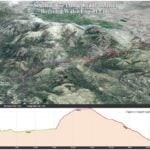Recycled Water Strategic Plan
The South Tahoe Public Utility District developed a Recycled Water Strategic Plan to determine the most cost-effective, innovative, and environmentally conscious way to manage recycled water in the future.
Background
The District collects, treats, and recycles wastewater from the South Lake Tahoe region. An average of 3.9 million gallons per day of recycled water is pumped 26 miles to the District's Diamond Valley Ranch, in Markleeville. Recycled water is stored in Harvey Place Reservoir and released in summer months to be used by ranchers and the District for irrigation.
The District began exporting recycled water to Alpine County in 1967 to comply with state and federal laws such as the Porter-Cologne Act and Public law 96-551. This requirement is unique to the Tahoe region and requires an enormous amount of energy to pump recycled water over mountain passes.
In 1988 the District entered a 40 year agreement to supply recycled water to six ranchers in Alpine County. In 2018, the District began growing alfalfa with recycled water on its Diamond Valley Ranch. In addition to recycling 100% of its wastewater, the District recycles 100% of its biosolids as fertilizer for agricultural land with Bently Agrodynamics in Douglas County, Nevada. The District also annually produces 381,000kw in hydroelectricity as recycled water flows from the top of Luther Pass 2,200 feet down into Hope Valley.
A Strategic Plan
There have been significant advances in and acceptances of water reuse over the last 50 years. As such, the District re-evaluated current operations and practices to identify the best ways to process and use recycled water in the future.
The Strategic Plan looks holistically to determine feasibility, innovation opportunities, hurdles, solutions, possibilities, and new technologies to treat and maximize the beneficial use of recycled water.
Location
Recycled water is pumped 26 miles, from South Tahoe PUD’s wastewater treatment to Harvey Place Reservoir in Markleeville, CA. Harnessing the water pressure from recycled water flowing from the top of Luther Pass down into Hope Valley, the District produces 381,000kw of hydroelectricity.
South Tahoe PUD owns and operates a 1,400-acre recycled water facility called Diamond Valley Ranch.


.webp?ixlib=rb-1.1.0&w=2000&h=2000&fit=max&or=0&s=92ef0c4e4afe92219e0f2fda848bbe2a)